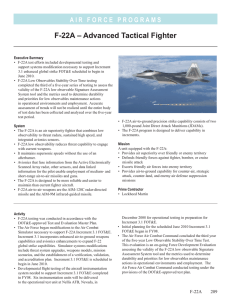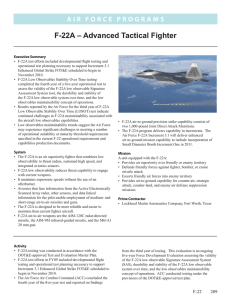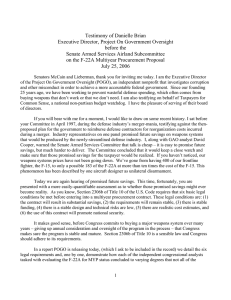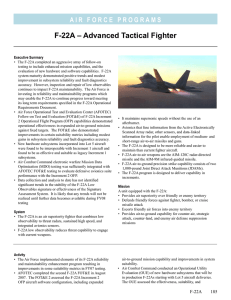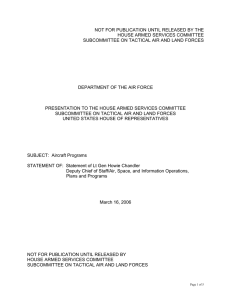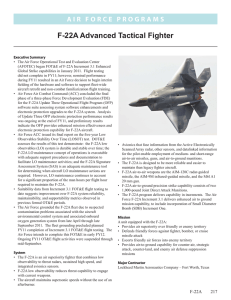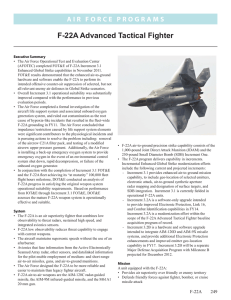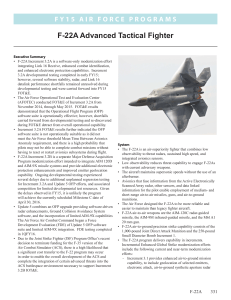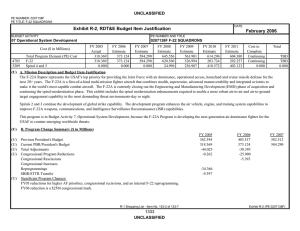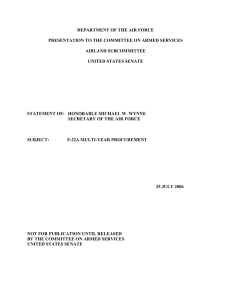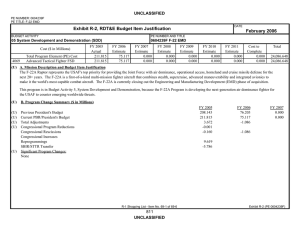F-22A – Advanced Tactical Fighter
advertisement
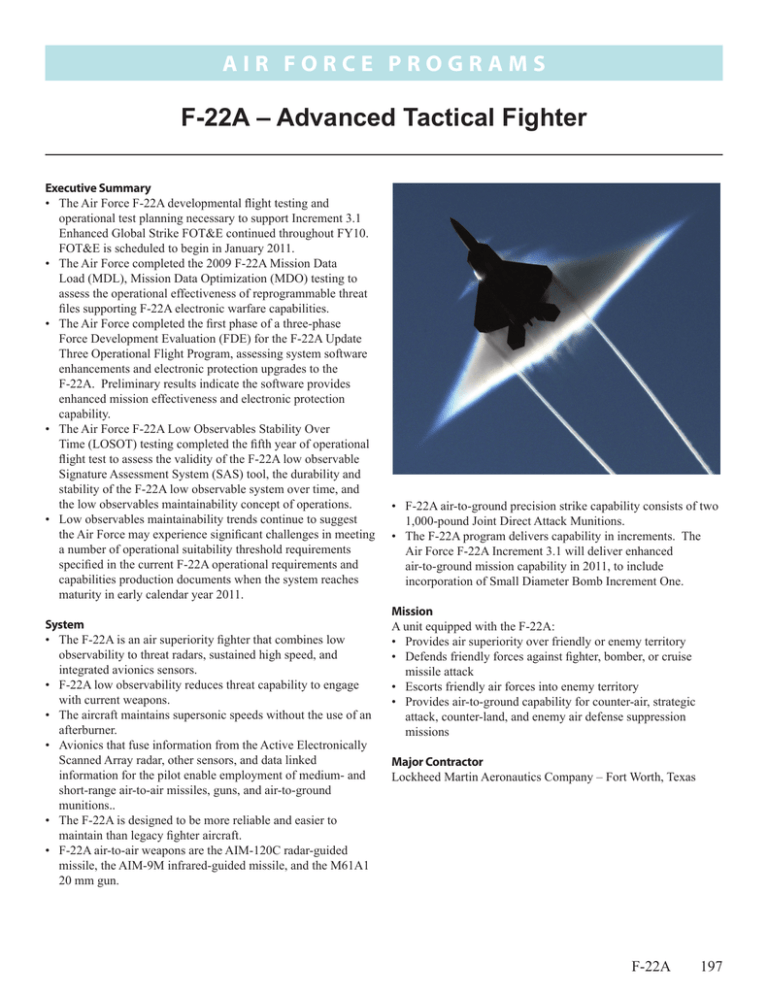
Ai r F o r c e P ROGRAMS F-22A – Advanced Tactical Fighter Executive Summary • The Air Force F-22A developmental flight testing and operational test planning necessary to support Increment 3.1 Enhanced Global Strike FOT&E continued throughout FY10. FOT&E is scheduled to begin in January 2011. • The Air Force completed the 2009 F-22A Mission Data Load (MDL), Mission Data Optimization (MDO) testing to assess the operational effectiveness of reprogrammable threat files supporting F-22A electronic warfare capabilities. • The Air Force completed the first phase of a three-phase Force Development Evaluation (FDE) for the F-22A Update Three Operational Flight Program, assessing system software enhancements and electronic protection upgrades to the F-22A. Preliminary results indicate the software provides enhanced mission effectiveness and electronic protection capability. • The Air Force F-22A Low Observables Stability Over Time (LOSOT) testing completed the fifth year of operational flight test to assess the validity of the F-22A low observable Signature Assessment System (SAS) tool, the durability and stability of the F-22A low observable system over time, and the low observables maintainability concept of operations. • Low observables maintainability trends continue to suggest the Air Force may experience significant challenges in meeting a number of operational suitability threshold requirements specified in the current F-22A operational requirements and capabilities production documents when the system reaches maturity in early calendar year 2011. System • The F-22A is an air superiority fighter that combines low observability to threat radars, sustained high speed, and integrated avionics sensors. • F-22A low observability reduces threat capability to engage with current weapons. • The aircraft maintains supersonic speeds without the use of an afterburner. • Avionics that fuse information from the Active Electronically Scanned Array radar, other sensors, and data linked information for the pilot enable employment of medium- and short-range air-to-air missiles, guns, and air-to-ground munitions.. • The F-22A is designed to be more reliable and easier to maintain than legacy fighter aircraft. • F-22A air-to-air weapons are the AIM-120C radar-guided missile, the AIM-9M infrared-guided missile, and the M61A1 20 mm gun. • F-22A air-to-ground precision strike capability consists of two 1,000-pound Joint Direct Attack Munitions. • The F-22A program delivers capability in increments. The Air Force F-22A Increment 3.1 will deliver enhanced air‑to‑ground mission capability in 2011, to include incorporation of Small Diameter Bomb Increment One. Mission A unit equipped with the F-22A: • Provides air superiority over friendly or enemy territory • Defends friendly forces against fighter, bomber, or cruise missile attack • Escorts friendly air forces into enemy territory • Provides air-to-ground capability for counter-air, strategic attack, counter-land, and enemy air defense suppression missions Major Contractor Lockheed Martin Aeronautics Company – Fort Worth, Texas F-22A 197 Ai r F o r c e P ROGRAMS Activity • The Air Force conducted F-22A testing in accordance with the DOT&E approved Test and Evaluation Master Plan and FOT&E and FDE test plans. • The Air Force continued F-22A Increment 3.1 Enhanced Global Strike developmental testing throughout FY10. The Air Force Operational Test and Evaluation Center (AFOTEC) finalized test planning efforts for Increment 3.1 FOT&E, scheduled to begin in January 2011. • AFOTEC conducted a series of simulator test events supporting F-22A Increment 3.1 FOT&E development in the F-22 Air Combat Simulator (ACS). The ACS facility consists of four F-22 cockpits installed in visual scene domes and ten other manned interactive cockpit stations and is designed to model the dense surface-to-air and air-to-air threat and electronic signals environment that is impractical or too costly to generate in open-air flight test. Ongoing validation, verification, and accreditation of the ACS for use in AFOTEC Increment 3.1 mission effectiveness evaluation occurred throughout FY10. • Air Force Air Combat Command (ACC) completed F-22A electronic warfare testing conducted under the May 2009 F-22 MDL, MDO FDE Test Plan. • Air Force ACC concluded the first phase of a three-phase FDE in July 2010 for the F-22A Update Three Operational Flight Program assessing system software enhancements and electronic protection upgrades to the F-22A system. • Air Force ACC concluded the final year’s flight testing for the five-year LOSOT test and reported on findings from the fourth year of testing. This evaluation assesses the validity of the F-22A low observable SAS, durability and stability of the F-22A low observable system over time, and the low observables maintainability concept of operations. • The Air Force instituted the F-22A Signature Management Program, a flight test program to verify the long term signature stability of the operational F-22A fleet and to continue to verify and refine SAS. In addition, the Signature Management Program assesses the completeness, correctness, and process clarity in management of the F-22A low observables system across the operational fleet. Assessment • The Increment 3.1 Enhanced Global Strike program experienced developmental challenges requiring additional software releases and flight test in FY10. The originally planned November 2010 through May 2011 FOT&E period is now scheduled from January through August 2011. Increment 3.1 FOT&E will include both open-air flight testing and complex missions conducted in the F-22 ACS. Evaluating F-22A Increment 3.1 capabilities in the context of the F-22’s anticipated operational threat and electronic signals environment requires that the ACS provide the realistic threat density and fidelity to complement open-air flight testing. • ACC 2009 MDL MDO testing verified and validated upgrades in F-22A reprogrammable mission data loads resulting in 198 F-22A • • • • the fielding of updated electronic warfare capabilities to operational units enabling enhanced global mission operations. Preliminary results from ACC Update Three FDE Phase One testing indicate the software provides enhanced mission effectiveness and electronic protection capability. ACC LOSOT fourth year interim findings indicate the following: - The F-22A SAS appears to be adequate for low observables maintenance documentation. Continual emphasis must be placed on training personnel to assure that low observable damages are properly identified and input into SAS so that accurate results are reported and proper maintenance can occur. - SAS is improving through periodic updates to increase the speed and usability of the program. - SAS data integrity should be maintained with regular audits and database checks performed by experienced low observables maintenance personnel. - As noted in the third year interim findings, continuation training for low observables maintenance personnel should be emphasized for the proper damage documentation and identification of correct logistics control numbers when using SAS. LOSOT findings are consistent with F-22 operational fleet trends and DOT&E FY07 follow-on operational testing observations. Low observables maintainability continues to account for a significant proportion of the man hours per flight hour required to maintain the F-22. This affects aircraft operational availability, mission capable rates, and sortie generation rates. LOSOT testing should be continued under the Signature Management Program or similar test venue after final reporting of the current ACC five year test and should include an assessment of the F-22A operational test fleet in addition to operational unit aircraft. The F-22A will reach 100,000 fleet flight hour system maturity in early 2011. Given the maintainability metrics achieved in operational testing to date, the Air Force is likely to experience significant challenges in meeting a number of “at maturity” operational suitability thresholds specified in the current F-22 operational requirements and capabilities production documents. DOT&E will assess the operational effectiveness and suitability of the mature F-22A system in conjunction with oversight of Increment 3.1 Enhanced Global Strike FOT&E. Recommendations • Status of Previous Recommendations. The Air Force continues to address all previous recommendations. • FY10 Recommendation. 1. The F-22A LOSOT testing should be continued under the Signature Management Program or similar test venue after final reporting of the current ACC test and should continue to include an assessment of the F 22 operational test fleet as well as operational unit aircraft.
